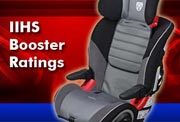Child Booster Seat Ratings From IIHS
 |
SEE ALSO: IIHS Booster Seat Rating Update
Booster seat evaluations
BEST BETS | GOOD BETS | Not recommended
New ratings from the Insurance Institute for Highway Safety take the guesswork out of selecting boosters most likely to provide good lap and shoulder belt fit in a range of vehicles. The Institute rates 9 belt-positioning boosters as BEST BETS and 6 as GOOD BETS out of 60 models examined in a new round of evaluations. Eleven boosters aren’t recommended at all because they do such a poor job of fitting the belt. Fit is important because safety belts are designed with adults in mind, not kids.
Proper belt fit
Boosters elevate children so that safety belts designed for adults will fit better. The lap belt should fit flat across a child's upper thighs, not across the soft abdomen, which is more likely to be injured in a crash than bony structures like the pelvis.
The shoulder belt should cross snugly over the middle of a child's shoulder. Then it's in position to provide effective protection in a crash. Plus it's comfortable to use, so a child won't be as likely to move it behind the back or under an arm.
 Test protocol
Test protocol
The Institute assessed the boosters at its Vehicle Research Center using a specially outfitted crash test dummy representing an average-size 6-year-old child. Engineers measured how 3-point lap and shoulder belts fit the dummy in each of the 60 boosters under 4 conditions spanning the range of safety belt configurations in vehicle models. Each booster gets 4 measurements for lap belt fit and 4 measurements for shoulder belt fit. An overall rating for each booster is then assigned based on the range of scores for the lap and shoulder belt measurements.
The Institute can't directly compare the new booster ratings with last year's results to see if particular seats have improved because engineers have modified the test device and protocol. The change makes it easier for manufacturers to reliably reproduce the results.


GOOD BELT FIT
Boosters elevate children so safety belts designed for adults will fit better. The lap belt should fit flat across a child's upper thighs, not the soft abdomen. Good boosters have belt-routing features that hold lap belts down and forward. The shoulder belt should cross snugly over the middle of the shoulder. Then it's in position to provide effective protection in a crash.
POOR BELT FIT
Not all boosters provide good belt fit. Here the lap belt is too high on the abdomen, and the shoulder belt is too low on the shoulder.


